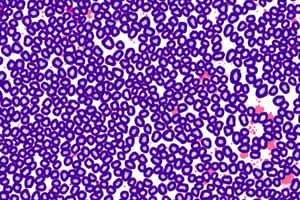Podcast
Questions and Answers
What type of epithelium is characterized by surface cells that undergo keratinization?
What type of epithelium is characterized by surface cells that undergo keratinization?
- Stratified cuboidal epithelium
- Stratified squamous keratinized epithelium (correct)
- Transitional epithelium
- Stratified columnar epithelium
Which type of stratified epithelium is primarily found in the ducts of sweat glands?
Which type of stratified epithelium is primarily found in the ducts of sweat glands?
- Stratified cuboidal epithelium (correct)
- Stratified columnar epithelium
- Transitional epithelium
- Stratified squamous keratinized epithelium
What occurs to transitional epithelium cells when the organ they line is distended?
What occurs to transitional epithelium cells when the organ they line is distended?
- They migrate away from the basement membrane
- They increase in number
- They become flattened (correct)
- They become more convex
What is the transitional epithelium classically described to consist of?
What is the transitional epithelium classically described to consist of?
What is NOT a characteristic feature of transitional epithelium?
What is NOT a characteristic feature of transitional epithelium?
What type of epithelium consists of a single layer of cells?
What type of epithelium consists of a single layer of cells?
Which type of simple epithelium is made of flattened cells?
Which type of simple epithelium is made of flattened cells?
Which of the following is an example of simple columnar epithelium?
Which of the following is an example of simple columnar epithelium?
Stratified squamous non-keratinized epithelium is typically found in which location?
Stratified squamous non-keratinized epithelium is typically found in which location?
What gives pseudostratified ciliated columnar epithelium its appearance?
What gives pseudostratified ciliated columnar epithelium its appearance?
Flashcards are hidden until you start studying
Study Notes
Epithelial Tissue
- Sheet of cells that forms a continuous layer on a basement membrane
- Covers body surfaces, lines body cavities and tubes, and forms glands
- Tightly packed cells with little intercellular matrix
- High regeneration capacity, varying from days to a month
Classification of Epithelium
- Simple Epithelium: single layer of cells
- Compound/Stratified Epithelium: multiple layers of cells
Simple Epithelium
- Simple Squamous Epithelium: flattened cells, found in the endothelium of the heart and blood vessels, mesothelium of serous membranes, and lining of alveoli
- Simple Cuboidal Epithelium: cube-like cells, found in the lining of thyroid follicles and the germinal epithelium of the ovary
- Simple Columnar Epithelium: tall columnar cells, found in the lining of the gastrointestinal tract and its glands, gallbladder, and bile duct
- Simple Ciliated Columnar Epithelium: simple columnar epithelium with cilia, found in the nasal epithelium
- Pseudostratified Ciliated Columnar Epithelium: type of epithelium with tall cells reaching the surface and shorter cells not reaching the surface, creating the appearance of multiple cell layers. Found in the lining of upper respiratory passages and air sinuses.
Compound/Stratified Epithelium
- Stratified Squamous Epithelium: surface layer made of squamous cells
- Stratified Squamous Non-Keratinized Epithelium: surface layer is moist, found in the lining of the oral cavity
- Stratified Squamous Keratinized Epithelium: surface layer is dry and exposed to air, cells undergo keratinization, found in the epidermis of the skin.
- Stratified Cuboidal Epithelium: surface layer made of cube-shaped cells, found in ducts of sweat glands and seminiferous tubules
- Stratified Columnar Epithelium: surface layer made of columnar cells, found in large ducts of glands
- Transitional Epithelium (Urothelium): special stratified epithelium lining the urinary tract (ureter, urinary bladder, urethra)
- Transition in Surface Cells: umbrella shaped when relaxed, flattened when distended
- Transition in Number of Layers: 5-6 layers when relaxed, 2-3 layers when distended
- Consists of three layers: superficial layer of large polyhedral cells, intermediate layer of pear-shaped cells, and a deeper layer of smaller cells.
- Connected to the basement membrane through cell junctions, preventing disruption during stretching.
Studying That Suits You
Use AI to generate personalized quizzes and flashcards to suit your learning preferences.




